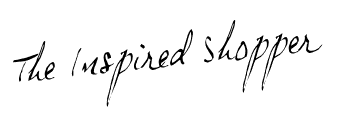11/10/12
The Smock - A Classic Style that Never Goes Out of Fashion
Posted by
Inspired
at
7:03 PM
This year as I've browsed the chain stores – one of my
favourite shopping habits – I've noticed something surprising. The smock top is
back. Well, not exactly, because it's never really been away.
How long has this fashion been around in its current
incarnation? Was it 2006 or 2007 that I first noticed a distinctive new,
untailored style that appeared initially in the form of what was called the sack
dress? It wasn't quite a smock, but was inspired by a similar concept of
unstructured fullness.
Simple smock tops became huge that year. Soon everything was
smocked, even short cropped jackets and sports hoodies. By today's standards
the smock tops of the mid-2000s were a bit dull, in uninspiring
colours and with not quite enough gathering at the seam running across the
sternum.
The smock evolved gradually from its 2006-07 incarnation,
with a number of variations, from the peasant style to the flowing top with
lots of gathering at a scoop neck. Present incarnations continue to play with
gathering and draping, and have been influenced by fashion's move to stronger
colours and abstract patterns; the peasant version is still prominent.
But
some things don't change: there is always something leisurely about the smock
that perhaps harks back to its rural origins, and makes us imagine sunning ourselves in
rustic pastures.
When I was researching this story, it was difficult to find
examples of recent smock styles among organic and fair trade brands, either in
Australia or overseas. Perhaps some of us are sick of the smock because its initial popularity was so over the top (pardon the pun) and we wore our smocks to death. Yet there are ethical styles out there - the smock above, from nixie clothing, is made from vintage silk scarves. The gorgeous smock dress below is by 3Fish:
And this extremely cute smock top is from odd molly:
But the beauty of smocks still being fashionable – or at
least not unfashionable – is that you can dig your old ones out from the back
of the cupboard and brighten them up with up-to-date neckwear. And because they
are a relatively recent style they're easy to find in op shops and thrift
stores.
Of course, there are still lovely vintage specimens around from
the 70s, like this one, from shinyredthings on Etsy.
I'm not a sewer but I imagine the smock style would be
relatively easy to make as it's less tailored than conventional shirts and
doesn't have a collar.
This enterprising blogger refashions men's work shirts into
smocks by cutting off the collar and gathering the neck, and replacing the original
sleeves with a puffy sleeve in a contrasting fabric. The results have a distinctive
crafted elegance.
History of the smock
top
Early smocks were worn by male peasant farmers in rural
Britain from the early eighteenth century onwards. They were made from heavy
wool or linen, and were more or less dresses – some a kind of 'shirt dress'
with buttons down the chest, as per the example below – or coats, with buttons all the way down. Embroidery
was added to the design in the nineteenth century (all of this illustrating
that gendered fashion is a cultural construct!).
The male smock had in turn been inspired by the chemise, a
loose undergarment worn by both men and women in Europe from the Middle Ages
onwards.
Yoked cotton smocks were popular with pregnant women from the 1940s (and possibly earlier), and of course there was the popular swagger-style
coat of the 1950s, which was loose and untailored.
But smock tops for women really hit their stride from the
late 1960s as part of the first wave of hippie chic. Hippie, or 'gypsy', chic
was inspired by traditional folkloric dress and smock tops were originally embroidered
peasant blouses, often made from cheesecloth and worn with blue flared jeans. Hippie
fashions like the peasant blouse were sometimes worn in direct defiance of
corporate culture.
Kirsten Dunst shows a modern take on this look below (though I suspect she is making a fashion statement rather than a political one!).
Kirsten Dunst shows a modern take on this look below (though I suspect she is making a fashion statement rather than a political one!).
As for the smock dress, brands as different as Mary Quant
and Laura Ashley made it their own. The Mary Quant example below is something
I'd be glad to wear today with a bit of fake tan on my white legs.
But I completely fell in love with this vintage smock dress, of unknown brand:
Back in the 70s (I am in fact quite ancient) my first
smock dress – or chemise as we used to call them – still creates a feeling of
fashion happiness when I think about it. It was made of cream calico, with
puffed short sleeves and brightly coloured embroidery on the chest. On the cusp
of adolescence, it made me feel like a fashion star. I adored myself in it.
The beauty of the smock dress is that you can belt some
versions of it. And you can also tuck your smock top into your jeans for a
blouson effect.
Not only that, but Alison DuBois from the hit TV show Medium convinced me that you could wear
a smock top under a jacket for a more tailored look while solving the odd murder. Perhaps she was also
psychic when it came to fashion!
Until next time!
If you enjoyed this blog entry, you might also like Wanted – An Annie Hall Look for the 2000s or The Tuck-In – A Versatile Look for the Frugally Fashionable.
Subscribe to:
Post Comments
(
Atom
)


























No comments :
Post a Comment